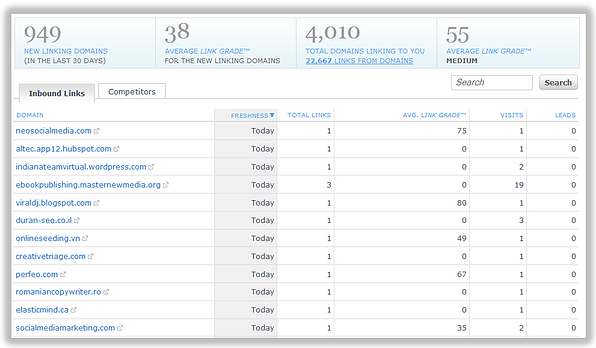This is an adapted excerpt from our new ebook, How to Unlock the ROI of Your Marketing Analytics. Download your free copy if you want to learn more about using data to make actionable improvements to your marketing. And don't forget to join today's #inboundchat on Twitter at 3:00pm EST, where we'll discuss these juicy marketing analytics topics!
Most marketers are always looking to improve their SEO -- after all, it drives free traffic to your website that you can convert into leads and customers. The thing is, to do it well, marketers must have the right metrics in place, monitor them consistently, and understand how to make agile adjustments to their daily marketing activities to move the numbers. This post will show you which SEO metrics to monitor, how to interpret those metrics, and what specifically you can do to move those numbers in the right direction. So without further ado, here's how you can use marketing analytics to improve your SEO!
Establish Your Baseline Metrics
It's hard to know where you're going if you don't know where you are. So before you begin improving your SEO, you need to establish some important baseline metrics. There are several free and paid tools out there that will let you compile this information if you don't already have a handle on these metrics. For this post, I'm going to show you how we do it using HubSpot's software. If you want to follow along and you're not a HubSpot customer, you can try out the software for free and track your keywords and SEO performance. These are the SEO metrics you should know, and what they mean.
1) Keyword Performance and Rankings - how well your website and web pages rank in search engines for desired search terms. From here on out, we'll refer to this as your listing position in the search engine results pages (SERPs). Using HubSpot, you can easily find this in the Keywords tool -- just select a keyword to see your listing position history.

2) Organic Search Traffic - the number of unique visitors who arrive at your site from a link on a search engine results page. Monitor what percentage of your website traffic comes from organic search every day, week, and month. This is simple to view in HubSpot -- just visit your "Sources," define the time period for which you're monitoring, and select "Organic Search" on the right.

3) Conversion Rates From Organic Search - the percentage of visitors who arrived at your site through organic search and completed a desired conversion action, such as becoming a lead. In this post, we'll be diving into the conversion rate of your organic traffic into leads and customers. You can find this on the same graph as above -- simply click the "Visit-to-Lead" box indicated in orange above to see the rate at which visitors from organic search become leads. Or, to see the rate at which visitors from organic search become customers, select "Customers" in the dropdown instead of "Visits," and select the box in the bottom right corner labeled "Visit-to-Customer."

4) Unique Search Terms Driving Traffic - the complete list of search phrases that visitors are using to find your site, and how much organic traffic those terms drive. You should pay particular attention to which non-branded keyword phrases (keyword phrases that don't mention your company name, products, or services) drive the most organic traffic to your website.

5) Inbound Links - a measure of the number of links back to your site from other sites on the web. You can see how many inbound links you have to your domain using HubSpot's Link Grader tool.

Drill deeper into each inbound link by clicking on the blue, hyperlinked text to see specific information about the link like the anchor text you received, and ensuring the link is passing along SEO credit.

Prioritize Keywords Based on Traffic and Conversion Rate
Now that you've established these important baseline metrics, tie all of the information together by looking at your closed-loop analytics. This will help you determine which search terms have driven the most qualified traffic -- in other words, traffic that converts into leads and customers. With this information, you can prioritize your SEO efforts on creating content and generating inbound links around search terms that drive qualified traffic to your website – not just any traffic. Prioritization through analytics is key when choosing which keyword phrases to target; otherwise, you'll find yourself spreading your efforts too thin and making little or no progress on any terms.
So you've run some reports like we did above and you know the keywords that drive the most organic traffic, and the rate at which those keywords convert into leads and customers. Let's say that those reports tell you that the term 'unicorn shoes' -- for which you rank in listing position 9 in the SERPs -- drives less traffic than the term 'unicorn hats' -- for which you rank in listing position 2 in the SERPs. But the traffic that comes to your site on the search term 'unicorn shoes' actually generated five new customers for your business last month, while the traffic that comes to your site for the term 'unicorn hats' has led to no customers. What do you do?
While it's great that 'unicorn hats' drives so much traffic to your website, it isn't as valuable to your business in the end -- that's why we look at closed-loop analytics! With this information, you know you should spend more time improving your position in the SERPs for the term 'unicorn shoes'; if it generates 5 customers in position 9, imagine how many it could generate for you in positions 1-3! Using marketing analytics to find the terms that are generating leads and customers for your business -- not just traffic -- will ensure you get the most qualified traffic to your website.
Adjust Your Content and SEO Strategy Accordingly
You know it's a priority to improve your listing position for 'unicorn shoes' in the SERPs now, so what do you do? You create content and generate quality inbound links around the term! It's important to understand that your content strategy and SEO strategy are inextricably tied; you won't have much organic success without a solid content strategy. So if you're looking to improve your SEO, you must be agile with your content strategy.
When thinking about what content to create to rank for 'unicorn shoes,' keep a closed-loop perspective in mind. That means you should consider not just what content will improve your rankings in the SERPs, but also what content will convert those organic visitors into leads that eventually become customers. Many marketers forget this step -- rejoicing in their number one position, but never monetizing that traffic with lead generation offers. So begin creating optimized blog content around the term 'unicorn shoes' to help improve your SERP listing, and accompany every blog post with a 'unicorn shoes'-related lead generation offer, as well. And remember, the landing pages that gate those offers can also rank in organic search! Finally, remember that there are many other places on your website to which you can publish fresh, search-friendly content that marketers often ignore -- consult this list for some inspiration.
While you work on increasing your listing position for 'unicorn shoes,' be sure to also target some new keywords that are relevant to your business model, generate good traffic, are a reasonable competitive level (more on that later), and for which you are currently not in the top 10 listing positions in the SERPs. You should balance top 10 keywords with top 20, 50, and 100 keywords because that far back in the SERPs, you're not generating organic traffic to your site from those terms ... but for all you know they could generate leads and customers at a great rate! If you balance your keyword targeting with a mix of keywords -- those for which you're in top 10, and those for which you're further back in the SERPs -- you'll be able to increase your current level of organic traffic while gaining positions over time.
Target the Right Balance of Keywords
The amount of content you'll need to create around the term 'unicorn shoes' to rank for it will depend on it's competitiveness, or difficulty level. You can determine how competitive a term is using HubSpot's Keyword Tool:

The higher the term's difficulty rating, the more, well, difficult it will be to rank for it. That means you'll need to generate more inbound links and create far more content over a longer period of time in order to get to page one in the SERPs. Unless you have unlimited time and resources, that's a problem, and it means you need to maintain a balance of competitive terms and less difficult terms when selecting the keywords you're targeting.
Now let's say 'unicorn shoes' is extremely competitive -- what do you do? You do some more keyword research in the Keyword tool to find related long-tail variations of the keyword that are less competitive, but still generate search traffic -- like 'fashionable unicorn shoes' and 'unicorn shoes for sale in Boston,' for example. Targeting long tail variations of the phrase 'unicorn shoes' will generate you organic traffic while working on your head term ranking, and will simultaneously help you rank for the head term 'unicorn shoes' that's contained within the long-tail keyword variations.
Continually Monitor Your Metrics
Finally, it’s important to monitor your listing position for the terms you’re currently driving traffic for -- especially those with high search volume and high competitiveness -- because you need to ensure you don’t suddenly slip in the SERPs to a competitor. Maintain a steady stream of content around the important keyword phrases for which you currently rank high in the SERPs, and if you notice your listing position begins to slip, amp up your content creation and link building efforts. It requires far less effort to stay in the top of the SERPs than it does to climb your way back up again.
What metrics do you look at to improve your search engine optimization? Share your recommendations, and don't forget to join our #inboundchat on Twitter today at 2:30 EST to discuss more about marketing analytics!
SEO Strategy







![How to Create an SEO Strategy [Template Included]](https://53.fs1.hubspotusercontent-na1.net/hubfs/53/SEO-Strategy.png)

![Should Marketers Optimize for Bing? [Data + Expert Tips]](https://53.fs1.hubspotusercontent-na1.net/hubfs/53/BING-SEO%20(1).png)


![How Web Strategists Think SGE Could Impact Search Pages [New Data]](https://53.fs1.hubspotusercontent-na1.net/hubfs/53/Copy%20of%20Featured%20Image%20Template%20Backgrounds%20(5)-1.png)
![How to Find SERP Feature Opportunities [+ Free Tools]](https://53.fs1.hubspotusercontent-na1.net/hubfs/53/serp-feature-opportunities.jpg)
